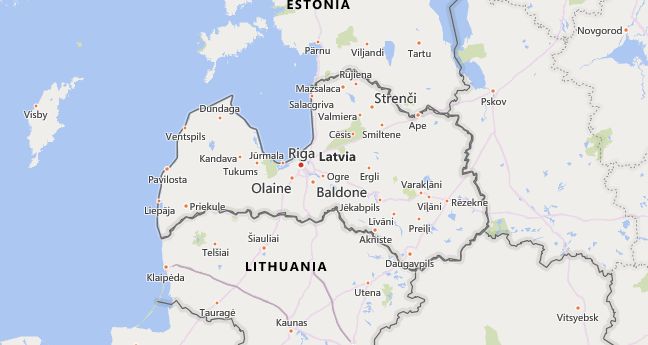There are 1 high school codes in Latvia today, according to the ACT. The full list is shown below by city, with name of each high school and the city where the school is located (based on the ACT official site). You can search a school code by pressing “Ctrl” + “F” and then type school name or 6-digit school code.
Map of Latvia
High School Codes by City
- High School Code
- 752000
The above lists CEEB codes (College Entrance Examination Board) for all accredited Latvian high schools. Please be informed that the list of high school codes in Latvia may change throughout the year. If you can’t find codes for the high schools of your interest, please write to us or come back at a later time. We will update our database soon after a new high school code is added to the country of Latvia.
Country Abbreviations
LVA is the three-letter country code of Latvia, and LV is the two-letter country code of Latvia. The two-letter suffix is used in top-level domains on the Internet as .lv.
Latvian arts
Latvian art, the art in what is now Latvia. Earliest evidence from the 9th – 4th centuries Millennium BC BC (clay figures, bone and amber jewelry, ceramics, carved wooden vessels) come from ancestors of the Baltic tribes.
Medieval Latvian art reflects the country’s mediator role between east and west. In stone architecture, which replaced traditional wooden construction around 1200, Romanesque (churches in Üxküll, Salaspils, Riga) and, from the end of the 13th century, Gothic forms were adopted from Western Europe, before an independent variant of the Gothic developed at the end of the 14th century (in Riga Dom Sankt Marien, Sankt-Petri-Kirche and Sankt-Johannis-Kirche). In medieval art, the work of north German workshops determined painting and sculpture (frescoes in the cathedral and in Sankt Jakob in Riga).
In the 16th century, forms of Renaissance and Mannerism penetrated (House of the Blackheads in Riga, 1334, rebuilt several times, facade from 1618, reconstructed). In the second half of the 17th century the baroque prevailed (Katharinenkirche in Kuldīga, Dannensternhaus in Riga). After the annexation to Russia (Peace of Nystad 1721), Latvian art also approached Russian (Baroque castles by B. F. Rastrelli in Rundāle and Jelgava). Classicism had a major influence (houses in Riga by Christoph Haberland, * 1750, † 1803; National Opera in Riga, 1860–63, by Ludwig Bohnstedt, * 1822, † 1885).
Around 1900, Art Nouveau created an exemplary combination of European and national modernism (residential buildings in Riga, especially in Albert- and Elisabethstraße, among others by Michail Eisenstein, * 1867, † 1921; Jānis Alksnis, * 1869, † 1939; Aleksandrs Vanags, * 1873, † 1919). A European, functionalist style was developed in the 1920s and 1930s, among other things. taken up by Osvalds Tilmanis (* 1900, † 1980) (apartment block in J. Asara Iela in the center of Riga, 1930). Since around 1960 there has been a connection to an international style (e.g. Dāiles Teātris Rīgā, 1959–76, by Imants Jācobsons, * 1934, † 1993). Forms of deconstructivism use z. B. Andrejs Gelzis (Latvian pavilion at the Expo 2000, Hanover).
Numerous visual artists in Latvia received their training in Saint Petersburg and worked there (Juli Fedders, * 1838, † 1909; Kārlis Hūns, * 1830, † 1877; Jānis Roze, * 1823, † 1897). A national art school also developed (group “Rūķis” with the painters Ādams Alksnis, * 1864, † 1897; Artūrs Baumanis, * 1892, † 1975; Jānis Rozentāls, * 1866, † 1916). Sculpture also gained importance (Gustav Šķilters, * 1874, † 1954; Teodors Zaļkalns, * 1876, † 1972). In the 1920s and 1930s national and European tendencies shaped the »Riga artist group« (Oto Skulme, * 1889, † 1967; Konrāds Ubāns, * 1893, † 1981). Gustav G. Kluzis (* 1895, † 1938), S. M. Eisenstein, Wera Ignatjewna Muchina and others worked in Moscow. During the Soviet rule, socialist realism became decisive (Jānis Tilbergs, * 1880, † 1972; Zaļkalns, Emils Melderis, * 1889, † 1979). Since the 1970s, the post-avant-garde has been a process of greater reflection on national traditions on the one hand and an orientation towards international styles on the other (including Andris Grinbergs, * 1946; Kristaps Ģelzis, * 1962; Ojārs Pētersons, * 1956; Juris Boiko, *) 1954; Miervaldis Polis, * 1948). Representatives of the »Riga Poetic School« include the documentary filmmaker Ivars Seleckis (* 1934) as well as the photographers Egons Spuris (* 1931, † 1990) and Inta Ruka (* 1958). The retro avant-garde has been developing multi-faceted strategies in painting, sculpture, performance and media art in post-communist society since the early 1990s by appropriating international art movements and national traditions. Questions about a socio-political, ethnic and global as well as cultural and personal context are preferably asked ironically and vehemently. Among other things, this occurs the group “Famous Five” (Martinš Ratniks, * 1975, among others), Gints Gabran ̆ s (* 1970) and Oleg Tillbergs (* 1956). Anita Zabilevska (* 1963), Kristīne Kursiša (* 1979) and the group “In Women’s League Project” lead a feminist discourse with subversive wit. The tradition of Latvian film is expanded by Ilmars Blumbergs (* 1943, † 2016) and Laila Pakalnina (* 1962).

